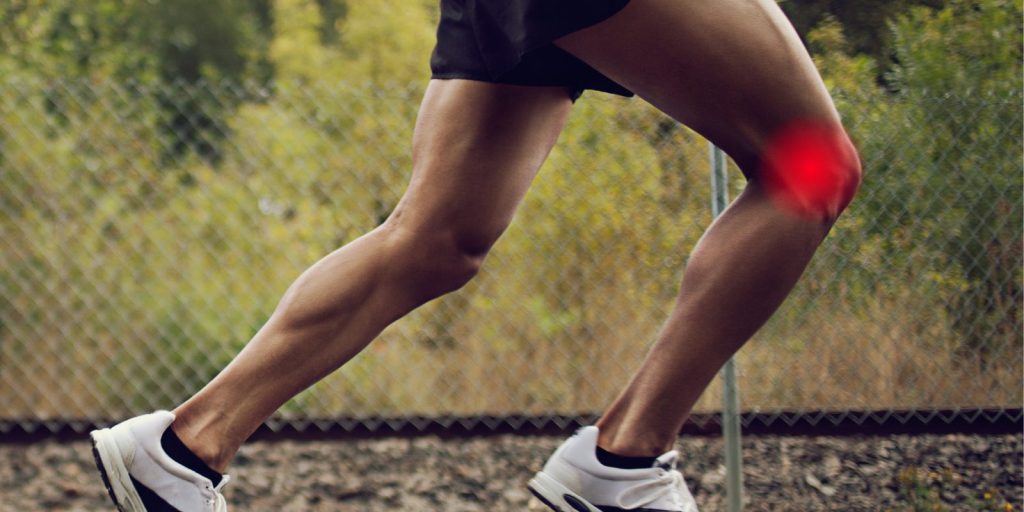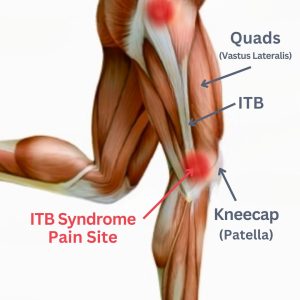
What Is Iliotibial Band (ITB) Syndrome?

ITB syndrome is a common running injury, with up to 15% of runners experiencing it at some time. It the most frequent running-related cause of pain on the outer side of the knee. The pain is usually fairly well localised, i.e. it doesn’t spread around too much. Although not medically “serious” it can become very painful and significantly limit your running, and if not managed well it can increase to a level that prevents you from running at all.
ITB syndrome is caused by irritation of the ITB (and possibly other related structures) as it crosses a bony prominence on the outer edge of the femur (thigh bone) called the femoral epicondyle. Biomechanically speaking, at about 300 of knee bending the ITB passes forwards and backwards across the bony epicondyle, and if it is excessively tight or compressed as it crosses over then painful irritation occurs.
What Causes ITB Syndrome?
Like most running injuries, ITB friction syndrome can be caused by several factors. Sometimes there is one obvious cause, e.g. a sudden spike in running volume, but sometimes the cause is not so obvious or may involve a number of factors, e.g. only a mild increase in volume (which would not normally be expected to cause ITB pain) but also running more on the track and trialling a new pair of running shoes.
The Three Most Common Causes Of ITB Syndrome Seen By Our Running Physios
1. Increasing Running Volume &/Or Intensity Too Quickly
This is the most common cause of ITB syndrome that we see in the clinic. If you want to increase your running volume or intensity you need to give your body’s tissues time to adapt to the increased loads. Pushing it too fast means you load your tissues, including your ITB, beyond their capacity and you are far more likely to get injured.
So how fast is too fast? Well, a 10% increase in volume each week is generally a good limit. A study published in the Clinical Journal of Sport Medicine found that runners who increased their training volume by more than 10% per week had a higher risk of developing ITB syndrome compared to those who increased their volume by less than 10%. It is worth noting that this 10% increase is generally a good and well-accepted guide for avoiding many running-related over-use type injuries.
2. Running Technique: Using A Cross-Over Gait
Numerous research studies have shown that increased hip adduction – i.e. where your foot lands towards, or even goes across, the midline of your body when running – is a risk factor for ITB syndrome (and also for other common running-related injuries)
3. Weakness Of The Gluteal Hip Muscles
Several studies have shown that weakness in the hip muscles, especially the glutes (gluteal muscles), increases the risk of developing ITB syndrome. On the flip side, several studies also show that strengthening your glutes will reduce your risk of developing ITB syndrome. Increasing your glutes strength is also an important and effective part of your treatment program for ITB syndrome.
There are a few possible mechanisms by which glute weakness increases your risk of ITB syndrome. Weakness of the glutes may contribute to the cross-over gait pattern discussed above, although research suggests that just strengthening your glutes doesn’t correct a cross-over gait by itself – you still need technique correction to make use of the extra strength. Weak glutes may also mean that more load is taken through the ITB to compensate, increasing the risk of ITB syndrome. Plus having weak glutes may be associated with a general lack of load-bearing capacity in structures around the hip and leg, meaning that your ITB may be less able in general to absorb loads during running. Whatever the exact combination of mechanisms is, the bottom line is the having weak glutes increases your risk of injury.
Does Running Shoe Choice Affect Your Risk Of ITB Syndrome?
Here is where personal choice, preference and response to different shoes becomes really important. There is some research to suggest that over-pronation may be related to an increased ITB risk however, footwear choice is a complex thing for runners so there is really no one-size-fits-all approach. What works great for one runner might do nothing or even make things worse for another. Also, switching running shoe types, e.g. from a cushioning shoe to a more control shoe may help with your ITB but it may also cause other problems elsewhere due to the change in your overall biomechanics.
So the main message about running shoes and ITB pain? See a running physio/professional to get properly assessed and review your overall biomechanics, training volume/intensity, injury history, running form and strength. Do this before you go and drop a significant chunk of money on new running shoes, because often your shoes are a minor factor, if relevant at all. Most runners will get far more benefit from putting their time and money into some quality coaching and strength and conditioning, rather than just buying some new shoes and hoping they help.
Other Factors That Can Cause ITB Syndrome
The above are the top 3 factors we have to address with the majority of our running clients with ITB syndrome, but other factors may be relevant and important for other runners. As discussed above, the choice of running shoe may be a factor for some people, but not others. Mobility and tightness may be relevant and important for some runners, and we work on this as required (usually early on in the program if needed, with the focus firmly switching to strength as they progress). And injury history may also be a significant factor for some runners, e.g. recurrent back pain, or knee pain on the other side, may be forcing a change in running biomechanics, so to effectively treat their ITB we may also need to sort out some other issues.
Other lifestyle factors may also be relevant, which aren’t specifically related to ITB pain. Things like sleep (or lack of), poor nutrition, recent illness (cold, flu, COVID…) and overall life stress have also been shown to play a significant role in exercise capacity and injury risk. For example a runner may have been comfortably pushing out 50k’s a week for several months with no problems, then work goes crazy and stressful, or their young child starts teething and they get broken sleep for a couple of weeks, and they start getting ITB pain for “no real reason”! It wasn’t that they increased their load (training volume, intensity…), it may just have been that these other lifestyle factors reduced their body’s ability to cope with that load, and an injury results.
ITB Syndrome Treatment – What Works?
While every ITB case and every runner is different, the most common and important parts of management plan for ITB syndrome are;
1. Load Management
Initial rest from running may be required, or in milder cases just temporarily dropping your running volume and/or intensity may be enough. We always try to minimise time completely off running, or the amount of reduction in running training, but de-loading the ITB and surrounding tissue is usually an important first step in effective ITB syndrome management. As your pain improves, you will gradually build up your training program again. It is worth noting that as well as overall running volume, load management may also include adjusting your intensity and type of runs, plus your running surface, e.g. track versus road.
2. Strengthening Of Your Gluteal & Hip Muscles
As discussed above, weak glutes and other hip muscles are a common cause of ITB syndrome coming on in the first place, and research also shows that increasing the strength of these muscles is an important part of your rehab program. Not only does it help you recover from this episode of pain, but it also minimises your chance of having further episodes in the future.
3. Running Gait Assessment And Improvement
Also as discussed above, having increased hip adduction leading to a cross-over running gait increases your risk of ITB problems. Therefore, part of your treatment program should include having your running gait assessed and corrected where necessary. As with strengthening exercises in the point above, not only does running gait correction have a role to play in helping you recover from this pain episode, it is also important in reducing your risk of having similar problems in the future.
Running Physio For ITB Syndrome Pain
If you have any questions or problems with running-related ITB or knee pain (or any other running injury for that matter!), or if your current/previous treatment just isn’t working, then feel free to call us on 9280 2322 or click below to ask us a question. You can also book online to begin your journey to get back out on the road again.

